Effect of Gum Arabic karroo as a Water-Reducing Admixture in Concrete
Abstract
:1. Introduction
2. Experimental Section
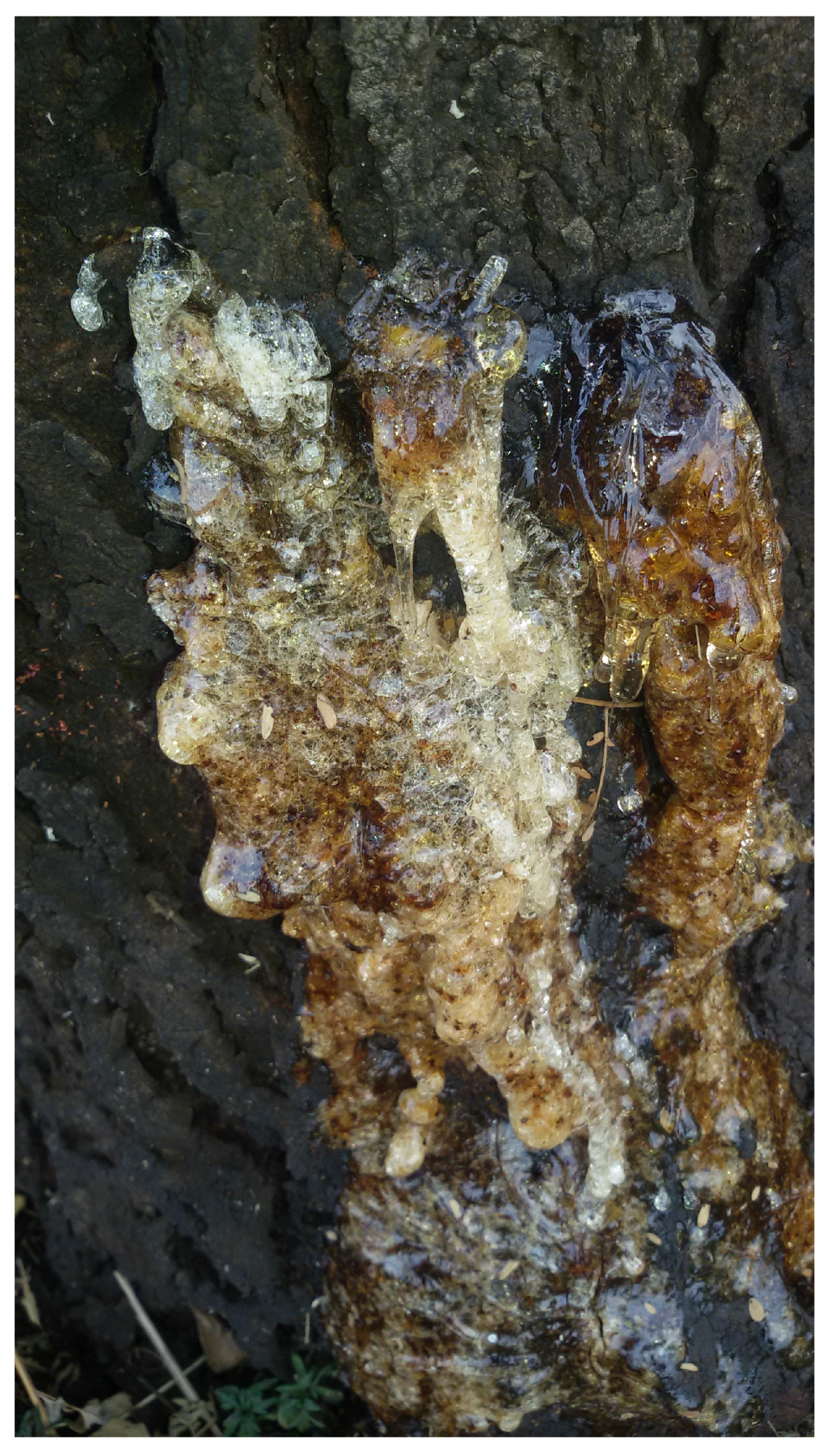
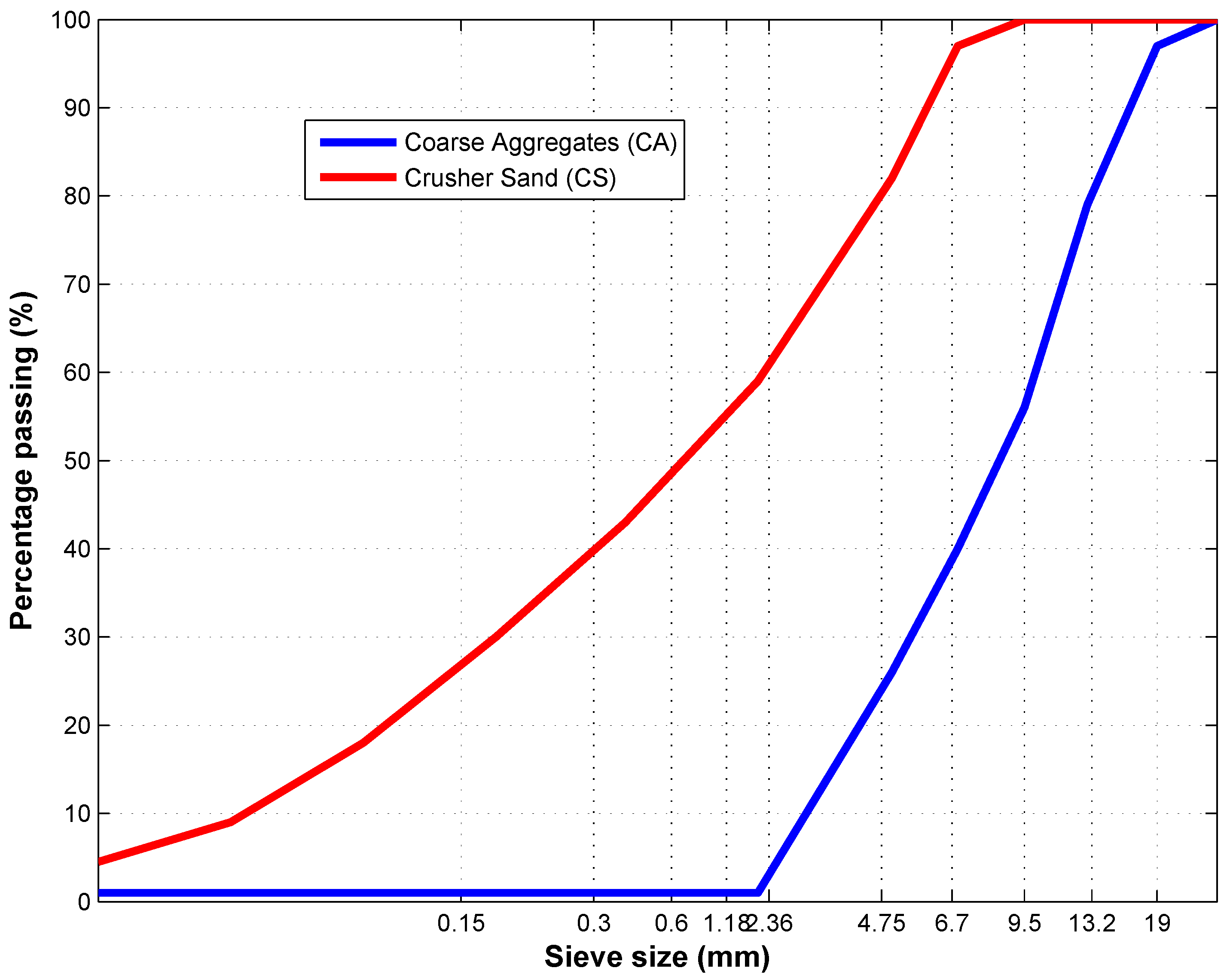
| Constituents | Cement (g per 100 g) | Fly Ash (Percentage by Mass) |
|---|---|---|
| SiO | 20.17 | 41.7 |
| AlO | 3.96 | 22.3 |
| FeO | 2.35 | 2.4 |
| MnO | 0.753 | - |
| TiO | 0.29 | - |
| CaO | 60.57 | 18.2 |
| MgO | 2.71 | 1.8 |
| PO | 0.09 | - |
| Cl | 96.8 ppm | - |
| SiO | 2.39 | - |
| NaO | 0.148 | 0.2 |
| KO | 0.37 | 0.2 |
| CaO | 1.50 | - |
| SO | 1.5 | - |
| Density (g/cm) | 3.12 | - |
| Blaine surface (cm/g) | 3240 | - |
2.1. Testing Procedures
3. Results and Discussion
3.1. Material Properties
3.2. Slump Test
| GAK Dosage | Cement (kg) | FA (kg) | CS (kg) | CA (kg) | Water (kg) | w/b | Slump (mm) | SD Slump |
|---|---|---|---|---|---|---|---|---|
| Control | 293 | 93 | 903 | 1190 | 241 | 0.6 | 70 | 5 |
| 0.3% | 293 | 93 | 903 | 1190 | 241 | 0.6 | 64 | 6 |
| 0.5% | 293 | 93 | 903 | 1190 | 241 | 0.6 | 60 | 8 |
| 0.7% | 293 | 93 | 903 | 1190 | 241 | 0.6 | 85 | 4 |
| 0.8% | 293 | 93 | 903 | 1190 | 241 | 0.6 | 90 | 3 |
| 1.0% | 293 | 93 | 903 | 1190 | 241 | 0.6 | 97 | 4 |
| 2.0% | 293 | 93 | 903 | 1190 | 241 | 0.6 | 210 | 1 |
| 3.0% | 293 | 93 | 903 | 1190 | 241 | 0.6 | 230 | 2 |
| 0.7% | 293 | 93 | 903 | 1190 | 196 | 0.5 | 50 | 8 |
| 0.8% | 293 | 98 | 903 | 241 | 196 | 0.5 | 55 | 9 |
| 1.0% | 293 | 98 | 903 | 216 | 220 | 0.56 | 58 | 8 |
| 2.0% | 293 | 98 | 903 | 206 | 206 | 0.52 | 45 | 1 |
| 3.0% | 293 | 98 | 903 | 187 | 187 | 0.48 | 60 | 2 |
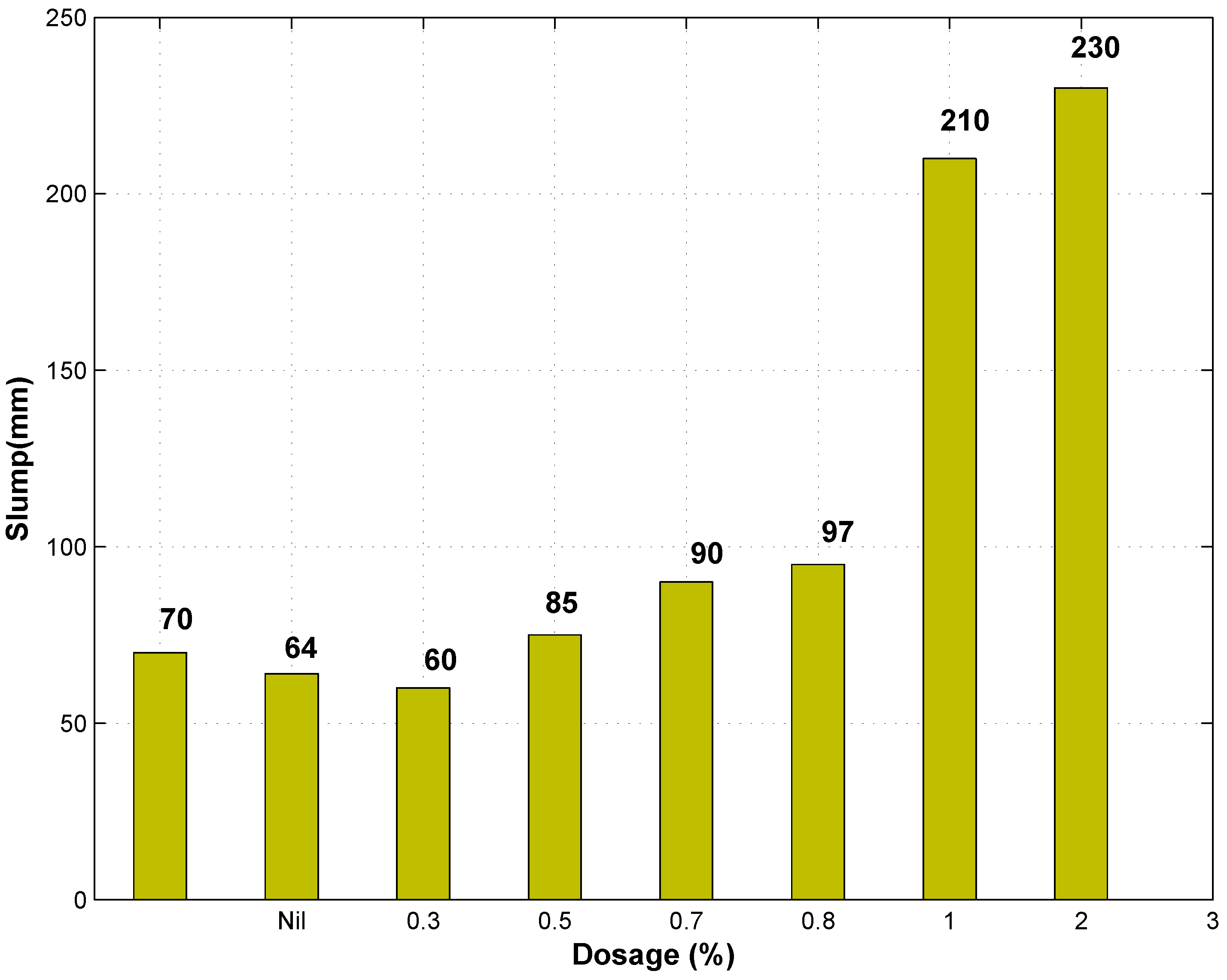
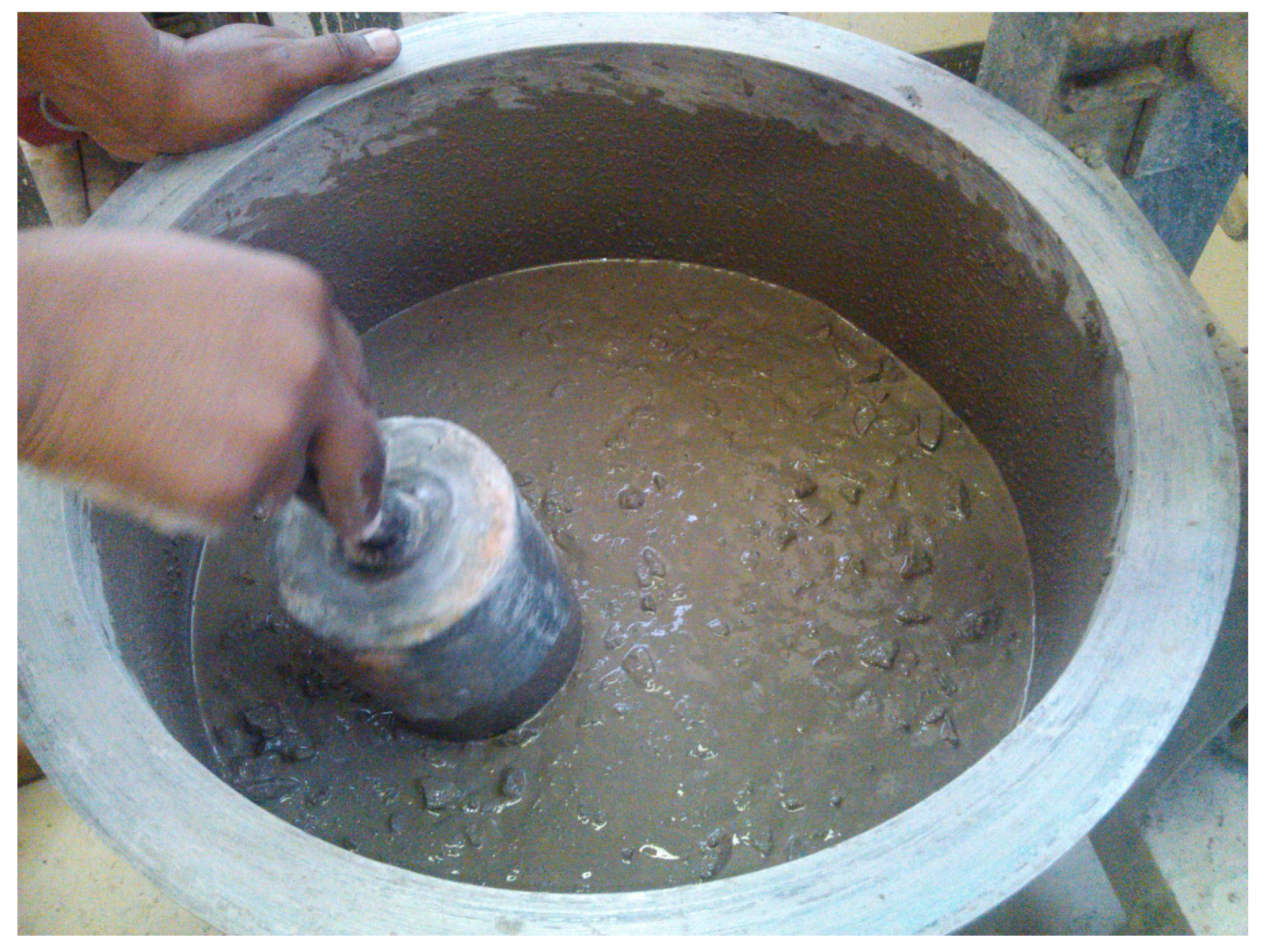
3.3. Density
| Dosage | Curing Age (Days) | w/b | |||||
|---|---|---|---|---|---|---|---|
| 3 | 7 | 28 | 56 | 120 | 180 | ||
| 0 | 2.462 | 2.476 | 2.47 | 2.464 | 2.485 | 2.482 | 0.61 |
| SD | 0.03 | 0.01 | 0.02 | 0.02 | 0.02 | 0.02 | |
| 0.3 | 2.512 | 2.463 | 2.484 | 2.478 | 2.454 | 2.463 | 0.61 |
| SD | 0.11 | 0.03 | 0.02 | 0.004 | 0.02 | 0.004 | |
| 0.5 | 2.448 | 2.45 | 2.447 | 2.451 | 2.454 | 2.482 | 0.61 |
| SD | 0.04 | 0.02 | 0.02 | 0.04 | 0.03 | 0.03 | |
| 0.7 | 2.436 | 2.438 | 2.441 | 2.442 | 2.448 | 2.456 | 0.61 |
| SD | 0.001 | 0.004 | 0.01 | 0.04 | 0.03 | 0.01 | |
| 1 | 2.439 | 2.441 | 2.44 | 2.444 | 2.443 | 2.498 | 0.61 |
| SD | 0.01 | 0.01 | 0.05 | 0.01 | 0.01 | 0.01 | |
| 0.7 | 2.449 | 2.475 | 2.49 | 2.46 | 2.5 | 2.47 | 0.5 |
| SD | 0.01 | 0.02 | 0.01 | 0.005 | 0.05 | 0.02 | |
| 0.8 | 2.464 | 2.469 | 2.51 | 2.5 | 2.51 | 2.5 | 0.5 |
| SD | 0.02 | 0.01 | 0.02 | 0.06 | 0.01 | 0.02 | |
| 1 | 2.434 | 2.422 | 2.461 | 2.492 | 2.534 | 2.512 | 0.56 |
3.4. Air Entrainment
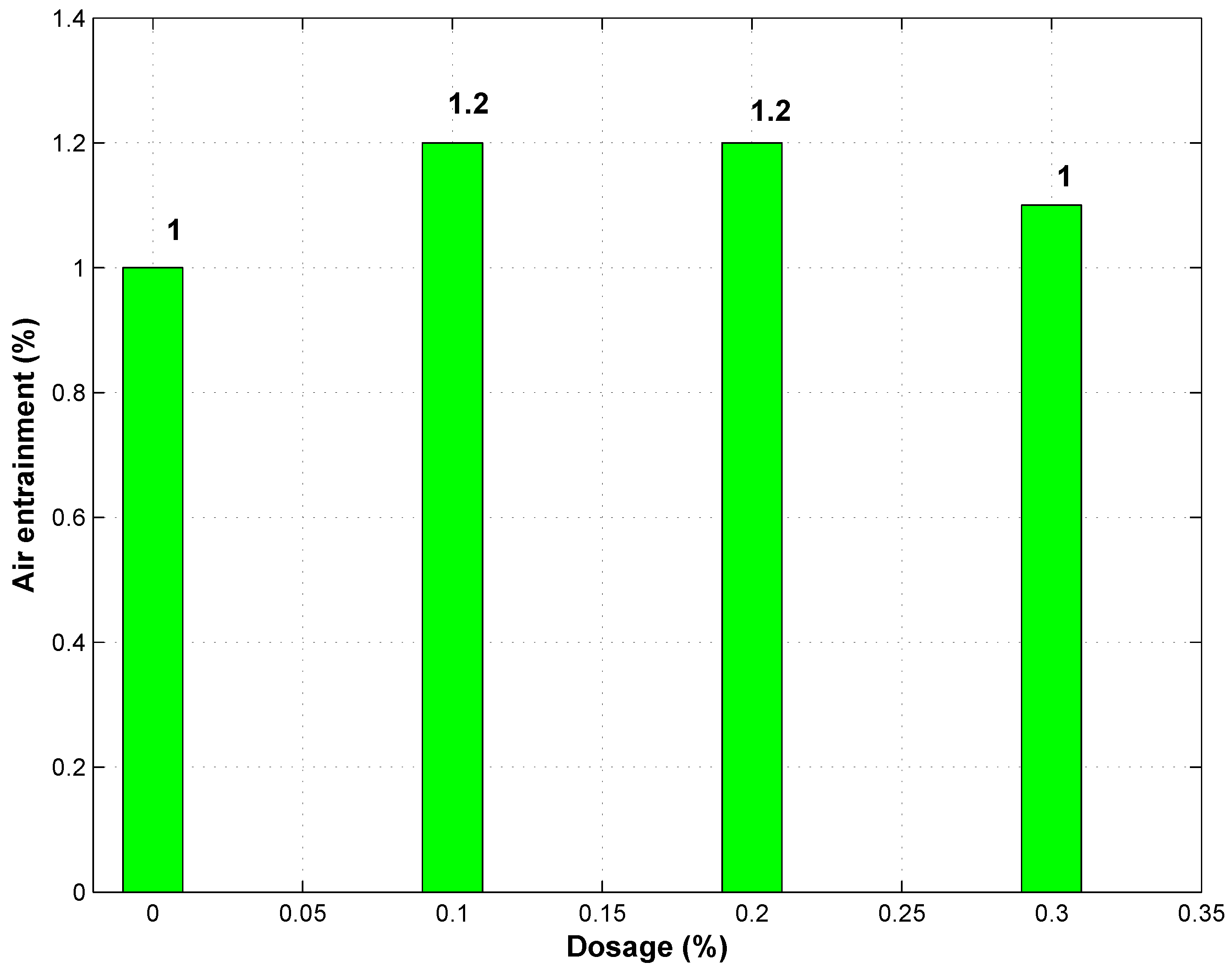
3.5. Compressive Strength
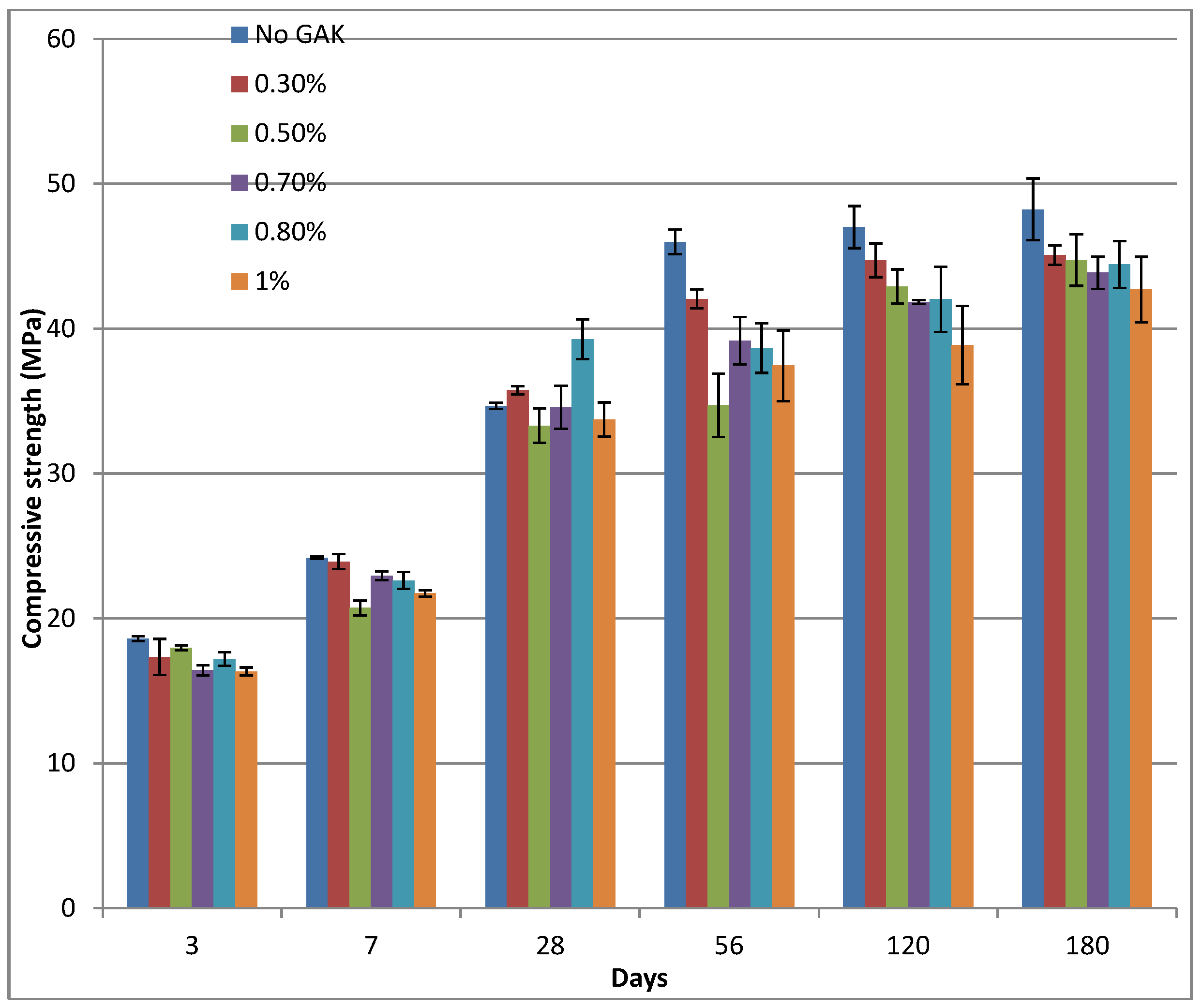
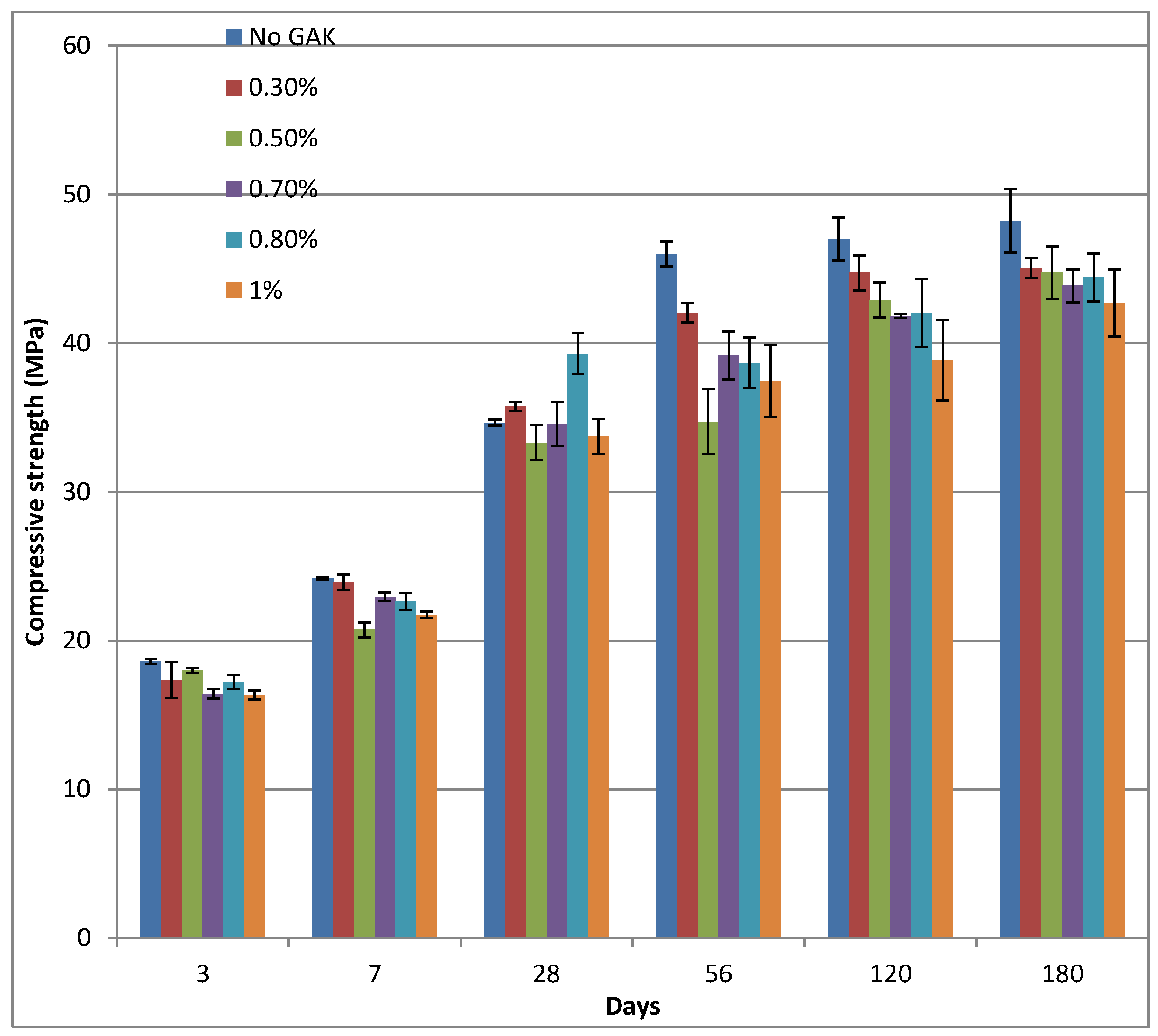
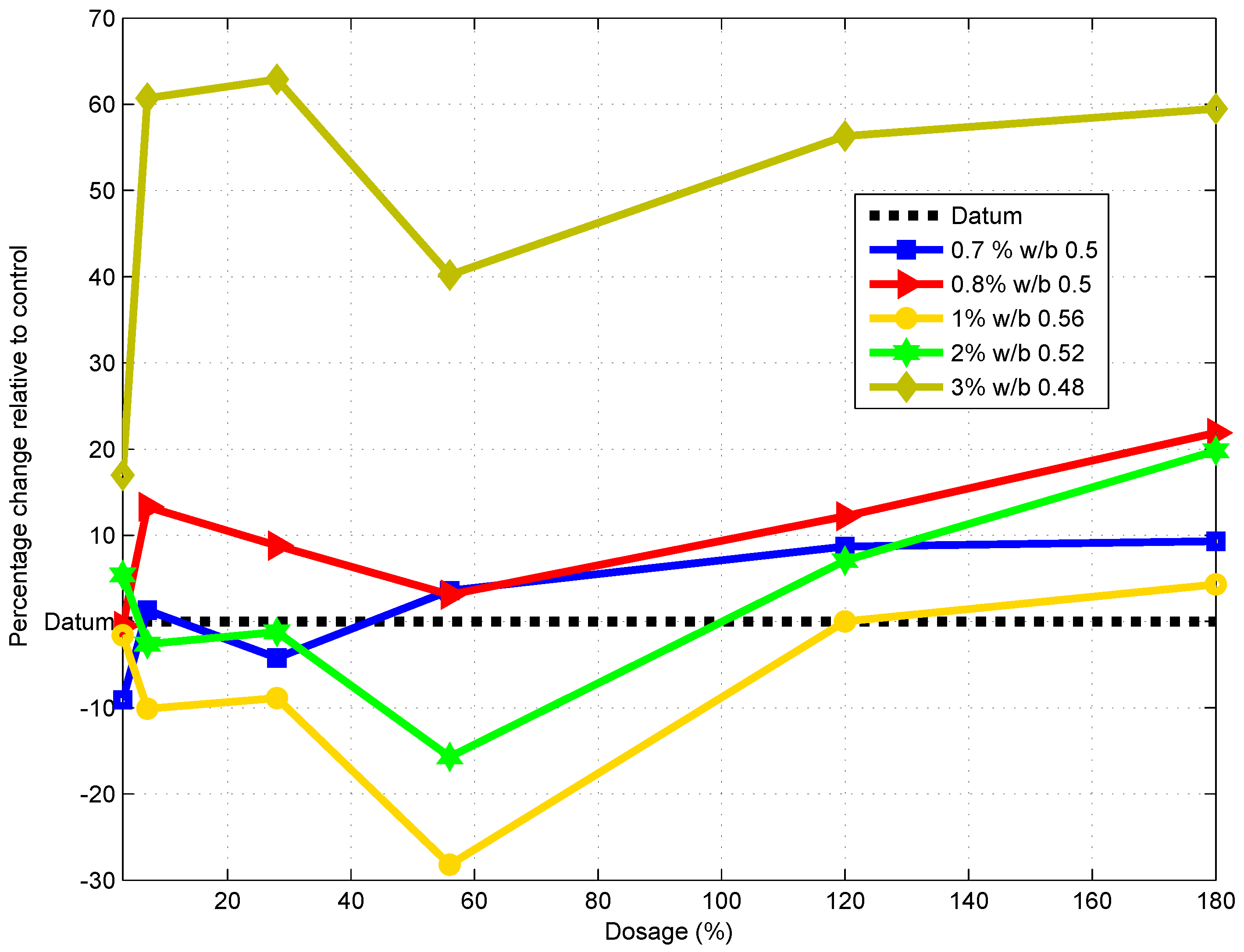
3.6. Carbonation
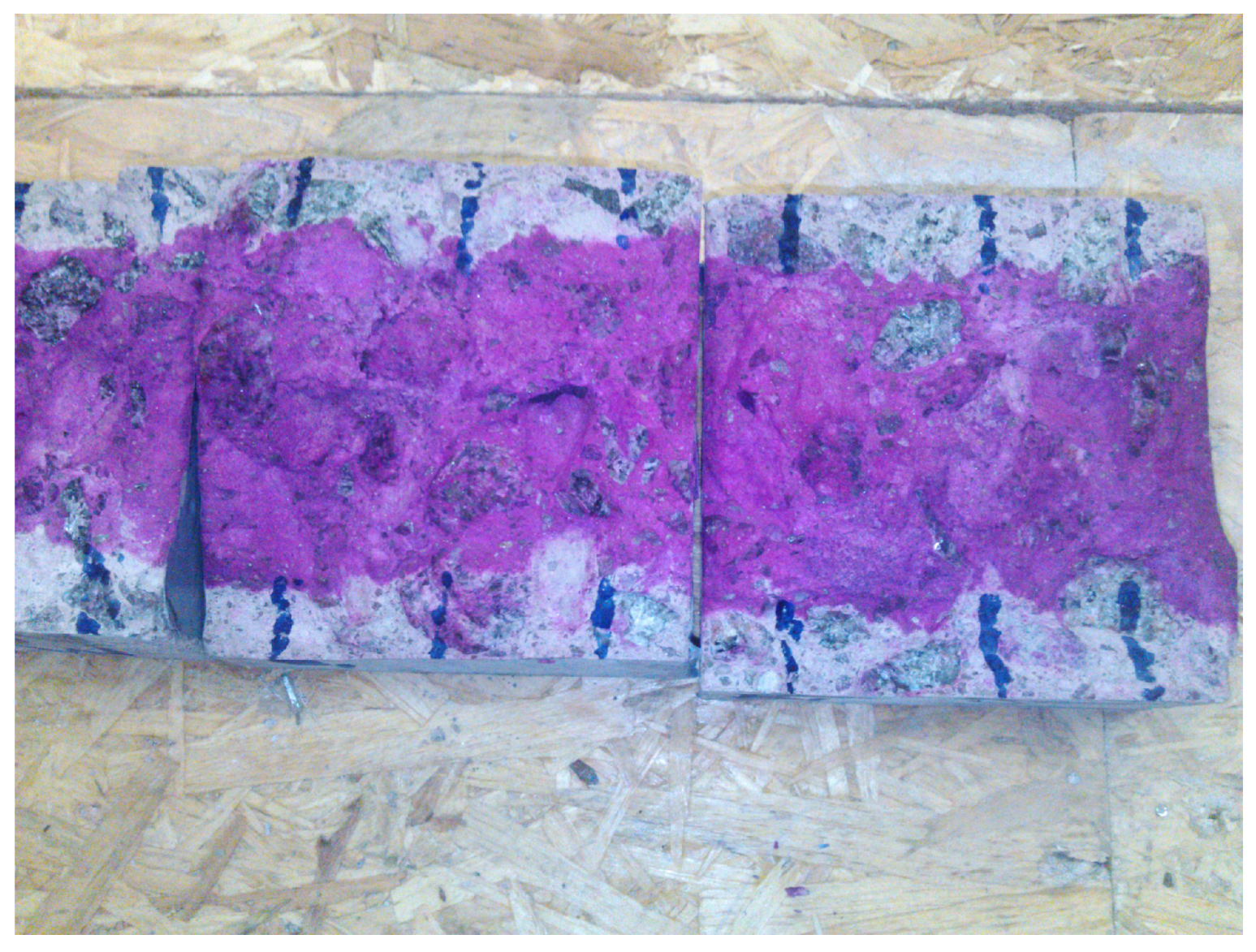
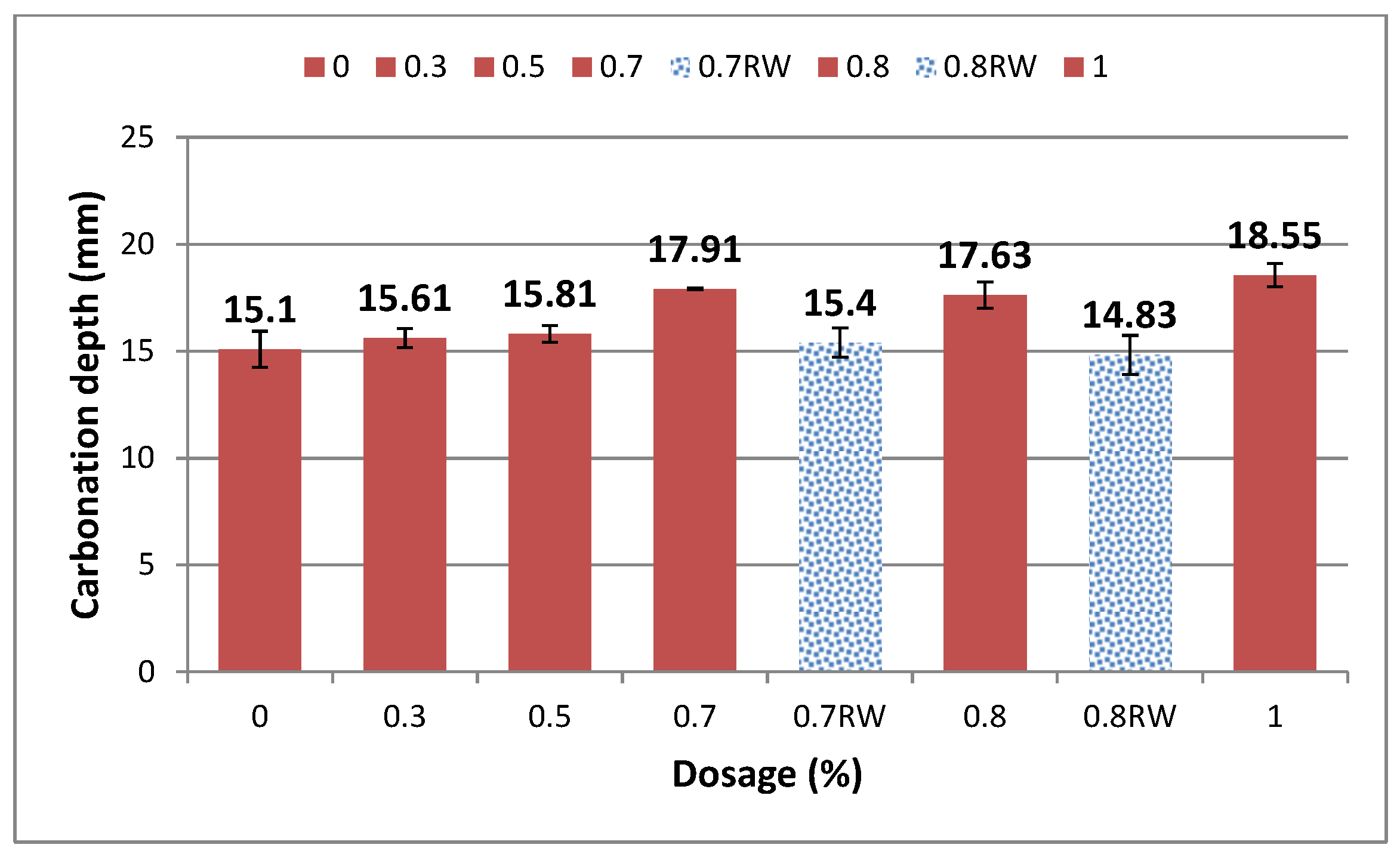
| Test | ||
|---|---|---|
| Samples | Depth (mm) | Comp.Strength (28 Days) |
| Control | 15.1 | 49.85 |
| 0.3 | 15.61 | 48.63 |
| 0.5 | 15.81 | 47.91 |
| 0.7 | 17.91 | 45.44 |
| 0.8 | 17.63 | 46.2 |
| 1.0 | 18.5 | 41.81 |
| 0.7 RW | 14.54 | 50.67 |
| 0.8 RW | 14.2 | 49.44 |
3.7. XRD Studies
| Sample | Quartz | Calcite | Portlandite |
|---|---|---|---|
| Control | 83.67 | 4.25 | 2.29 |
| 3% RW | 76.73 | 0.74 | 1.73 |
| 2% RW | 82.85 | 0 | 2.32 |
| 1% | 84.28 | 2.49 | 3.25 |
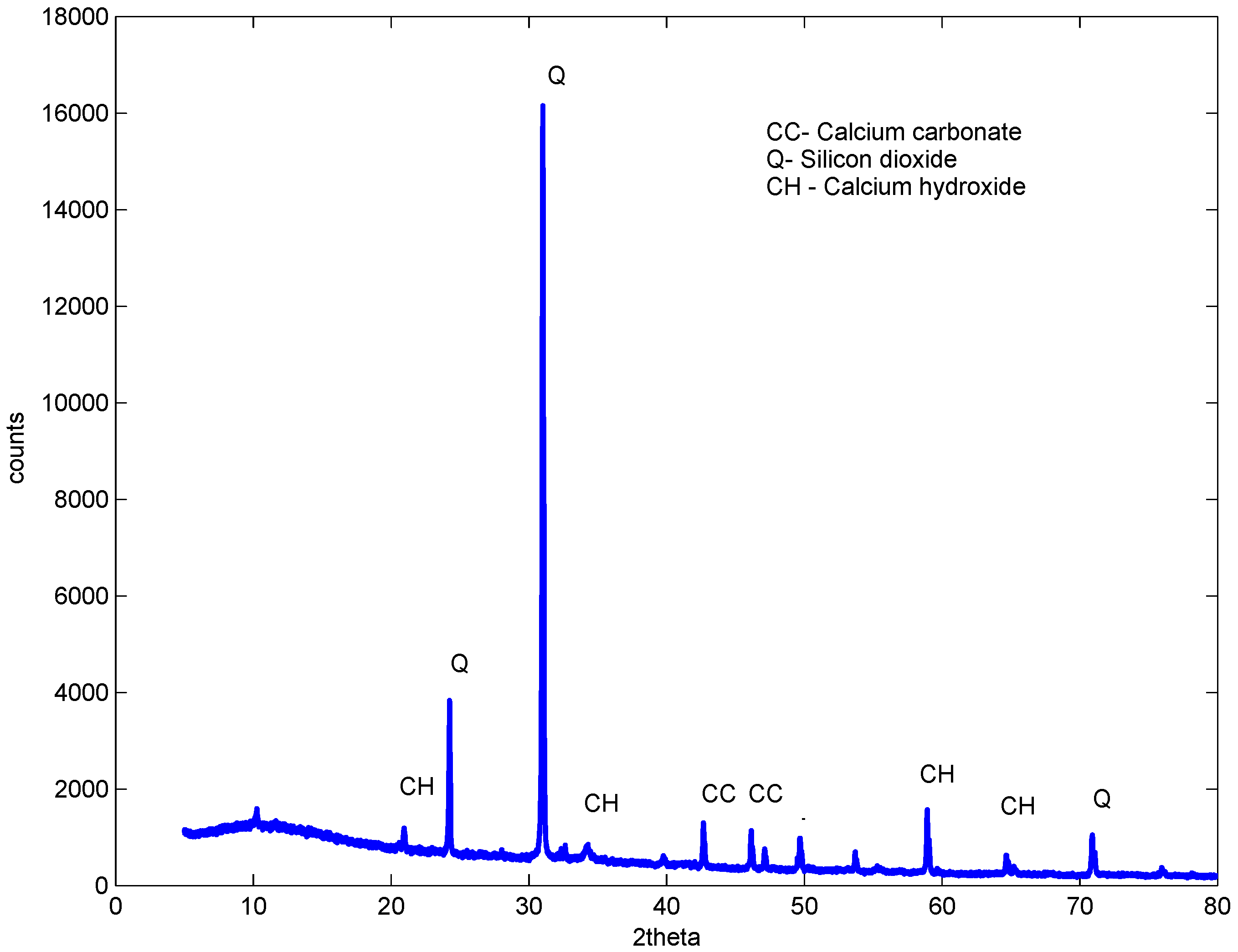
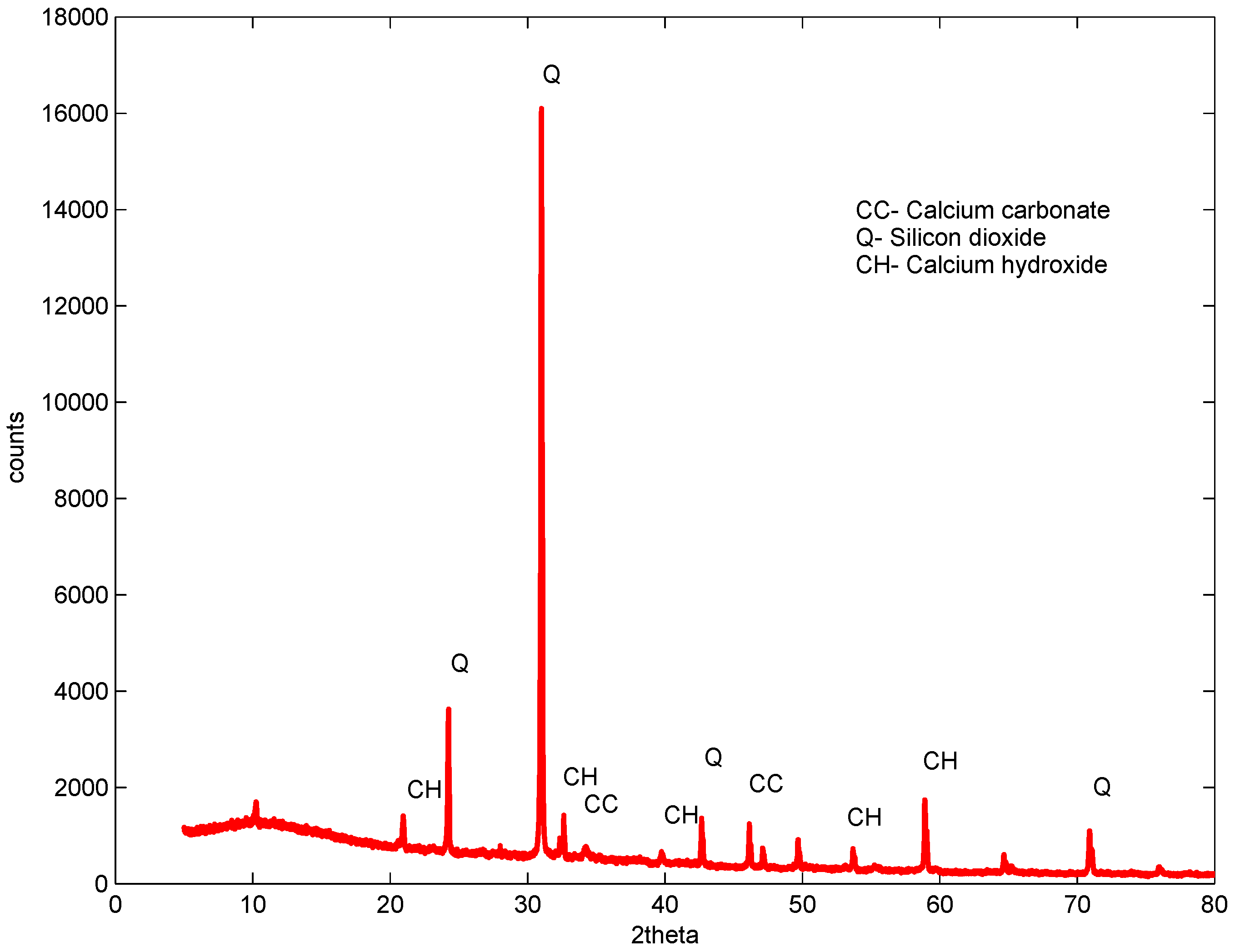
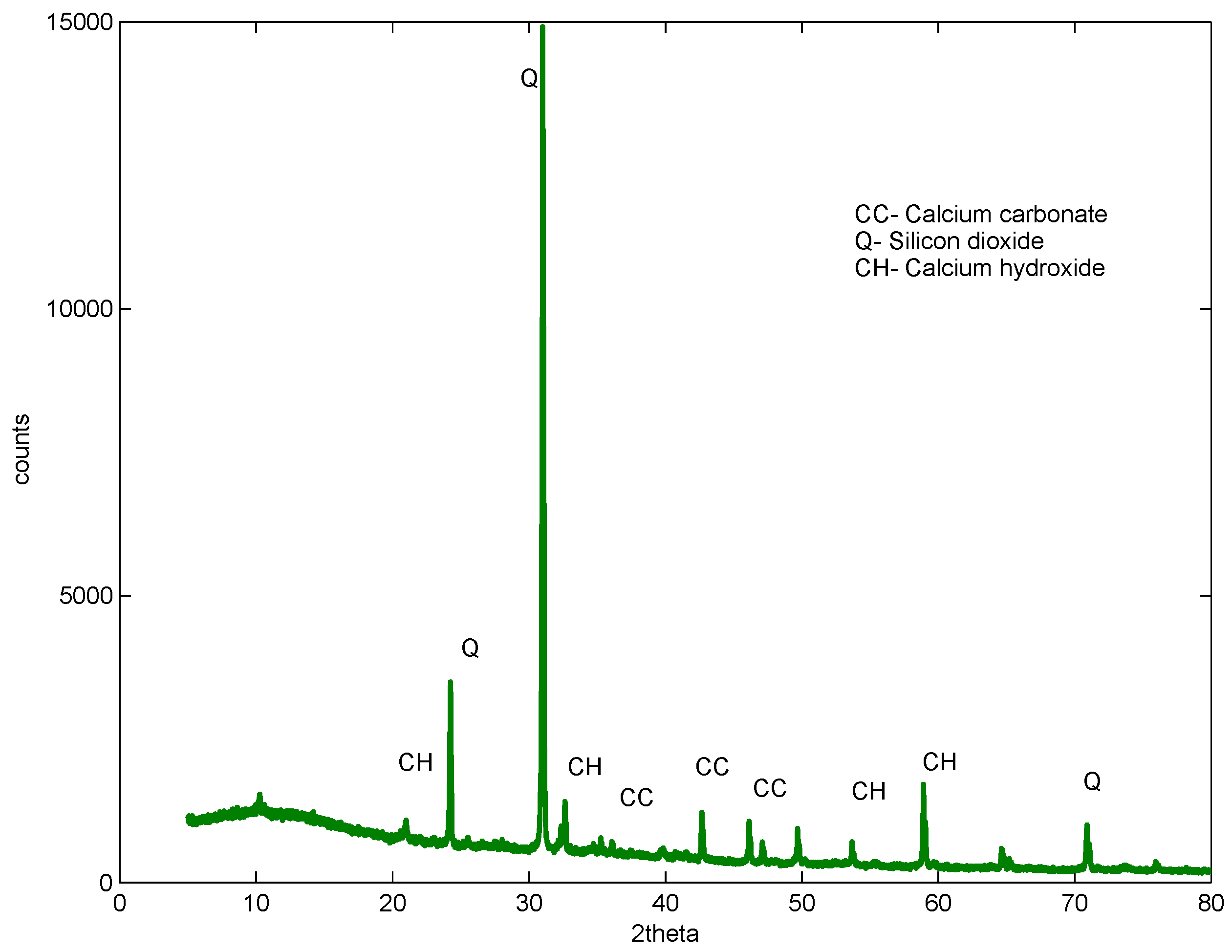

4. Conclusions
- (1)
- In hot weather climates, there is a tendency to add water to concrete to make it more workable. The addition of GAK to concrete can reduce this tendency. There was a remarkable improvement of concrete workability when GAK was used at above a 0.5% dosage. At a 2% dosage, the slump of concrete increased by 200%. However, the drawback observed was the quick slump loss due to the adhesive nature of GAK. This type of concrete is applicable in pre-cast technology.
- (2)
- The increase in GAK dosage reduced the compressive strength and density of concrete. The air content also increased with increased dosage, which could have contributed to the compressive strength reduction. The highest decrease in compressive strength observed was 24.5% lower than the control at a 0.5% GAK dosage. In the case of a reduced w/b ratio from 0.61 to 0.48, the highest strength was observed at 3% GAK at all ages. The strength gain at 180 days was 37.03% higher than the control. The use of GAK as a water-reducing admixture is a possibility. Increased strength means GAK can be used as a water-reducing admixture, resulting in the reduction of cement demand, which in turn reduces carbon emissions and energy used, thereby providing the construction industry with a cleaner, greener and environmentally-friendly admixture. In addition, the gain of strength at an early age means formwork can be removed earlier, thereby decreasing construction time.
- (3)
- The carbonation depth of concrete slightly increased with increased GAK dosage. The highest carbonation depth increased by 22.8% at a 1% dosage above the control. Samples with a reduced w/b ratio showed a decrease in carbonation.
- (4)
- The XRD analysis gave an idea of the effect of GAK on hydration. The addition of GAK at higher dosages enables lower w/b ratios. This, in turn, showed an improved hydration rate relative to the control.
Acknowledgments
Author Contributions
Conflicts of Interest
References
- Stark, J. Recent advances in the field of cement hydration and microstructure analysis. Cem. Concr. Res. 2011, 41, 666–678. [Google Scholar] [CrossRef]
- American Concrete Institute. Specifications for Structural Concrete. Pumping Aids; ACI 301-05; ACI Education Bulletin, American Concrete Institute: Farmington Hills, MI, USA, 2005. [Google Scholar]
- Lachemi, M.; Hossain, K.M.A.; Nkinamubanzi, P.C.; Bouzoubaâ, N. Self-consolidating concrete incorporating new viscosity modifying admixtures. Cem. Concr. Res. 2004, 34, 917–926. [Google Scholar] [CrossRef]
- Rols, S.; Hossain, J.; Pera, J. Effects of different viscosity agents on the properties of self-leveling concrete. Cem. Concr. Res. 1999, 29, 261–266. [Google Scholar] [CrossRef]
- Khayat, K.H. Viscosity-enhancing admixtures for cement-based materials—An overview. Cem. Concr. Compos. 1998, 20, 171–188. [Google Scholar] [CrossRef]
- Schmidt, W. Challenges of the African environmental conditions for concrete mixture composition. In Proceedings of the Workshop Cement and Concrete for Africa, Berlin, Germany, 17 August 2011; pp. 37–49.
- Williams, P.A.; Phillips, G.O. Gum Arabic. In Handbook of Hydrocolloids; Phillips, G.O., Williams, P.A., Eds.; Elsevier: Philadelphia, PA, USA, 2009; pp. 253–259. [Google Scholar]
- Abdeljaleel, N.S.; Hassaballa, A.E.; Mohamed, A.; Rahman, E. The Use of Gum Arabic Liquid and Modified Liquid in Concrete Mixes. Innov. Syst. Des. Eng. 2012, 3, 1–11. [Google Scholar]
- Abdeljaleel, N.S.; Hassaballa, A.E.; Mohamed, A.; Rahman, E. Determination of the Physio-Chemical Properties of Nigerian Acacia Species for Foundry Sand Binding Applications. Res. J. Appl. Sci. Eng. Technol. 2009, 1, 107–111. [Google Scholar]
- Williams, P.A.; Phillips, G.O.; Randall, R.C. Structure-function relationships of gum arabic. Gums Stab. Food Ind. 1990, 5, 25–36. [Google Scholar]
- Poinot, T.; Bartholin, M.; Govin, A.; Grosseau, P. Structure-function relationships of gum Influence of the polysaccharide addition method on the properties of fresh mortars. Cem. Concr. Res. 2015, 70, 50–59. [Google Scholar] [CrossRef] [Green Version]
- South African Bureau of Standards. Aggregates from Natural Sources: Aggregates for Concrete; SANS 1083; South African Bureau of Standards: Pretoria, South Africa, 2006. [Google Scholar]
- Alexander, M.; Mindess, S. Aggregates in Concrete; CRC Press: Boca Raton, FL, USA, 2005. [Google Scholar]
- South African Bureau of Standards. Concrete Testing: Making and Curing of Test Specimens; SANS 5863-3; South African Bureau of Standards: Pretoria, South Africa, 2006. [Google Scholar]
- European Committee for Standardization. Testing Fresh Concrete: Air Content: Pressure Methods; EN 12350-7; BSI: London, UK, 2009. [Google Scholar]
- South African Bureau of Standards. Concrete Tests–Compressive Strength of Hardened Concrete; SANS 5863-3; South African Bureau of Standards: Pretoria, South African, 2006. [Google Scholar]
- Gonen, T.; Yazicioglu, S. The influence of mineral admixtures on the short and long-term performance of concrete. Build. Environ. 2007, 42, 3080–3085. [Google Scholar] [CrossRef]
- Sakata, N.; Maruyama, K. 20 Basic Properties and Effects Of Welan Gum on Self—Consolidating Concrete. Prod. Methods Work. Concr. 2004, 32, 237–318. [Google Scholar]
- Mailvaganam, N.P.; Rixom, M.R. Chemical Admixtures for Concrete; CRC Press: Boca Raton, FL, USA, 2007; pp. 32–58. [Google Scholar]
- Ghio, V.A.; Monteiro, P.J.M.; Gjorv, O.E. Effect of polysaccharide gums on fresh concrete properties. ACI Mater. J. 1995, 91, 602–606. [Google Scholar]
- Khayat, K.H. Effects of antiwashout admixtures on fresh concrete properties. ACI Mater. J. 1995, 92, 164–171. [Google Scholar]
- Collepardi, M. Admixtures-enhancing concrete performance. In 6th International Congress of Global Construction; Thomas Telford: London, UK, 2005; pp. 55–66. [Google Scholar]
- Hewlett, P. Lea’s Chemistry of Cement and Concrete; Butterworth-Heinemann: London, UK, 2003; pp. 320–350. [Google Scholar]
- Ramachandran, V.S. Concrete Admixtures Handbook: Properties, Science and Technology; Noyes Publication: Ottawa, ON, Canada, 1995; pp. 95–100. [Google Scholar]
- Neville, A.M.; Brooks, J.J. Concrete Technology, 2nd ed.; Peaeson: Kuala Lumpur, Malaysia, 2010; pp. 161–162. [Google Scholar]
- Wada, T.; Matsuura, K.; Kato, M.; Matsuda, H. Google Patents Cement, Polysaccharides, Water, Reinforcing Fibers, Coagulants, Hardened by Hydration. U.S. Patent 5,154,771, 13 October 1992. [Google Scholar]
- Chandra, S.; Eklund, L.; Villarreal, R.R. Use of cactus in mortars and concrete. Cem. Concr. Res. 1998, 28, 41–51. [Google Scholar] [CrossRef]
- Łaźniewska-Piekarczyk, B. The influence of selected new generation admixtures on the workability, air-voids parameters and frost-resistance of self compacting concrete. Constr. Build. Mater. 2012, 31, 310–319. [Google Scholar] [CrossRef]
- Ouyang, X.; Guo, Y.; Qiu, X. The feasibility of synthetic surfactant as an air entraining agent for the cement matrix. Constr. Build. Mater. 2008, 22, 1774–1779. [Google Scholar] [CrossRef]
- Rajabipour, F.; Sant, G.; Weiss, J. Interactions between shrinkage reducing admixtures (SRA) and cement paste’s pore solution. Cem. Concr. Res. 2008, 22, 606–615. [Google Scholar] [CrossRef]
- Ma, L.; Zhao, Q.; Yao, C.; Zhou, M. Impact of welan gum on tricalcium aluminate—Gypsum hydration. Mater. Charact. 2012, 64, 88–95. [Google Scholar] [CrossRef]
- Adedokun, D.A. Optimizing Green House Carbon Dioxide Sequestration by Concrete. Master’s Thesis, Tshwane University of Technology, Pretoria, South Africa, 2014. [Google Scholar]
- Valcuende, M.; Parra, C. Natural carbonation of self-compacting concretes. Constr. Build. Mater. 2010, 24, 848–853. [Google Scholar] [CrossRef]
- Khunthongkeaw, J.; Tangtermsirikul, S.; Leelawat, T. A study on carbonation depth prediction for fly ash concrete. Constr. Build. Mater. 2010, 20, 744–753. [Google Scholar] [CrossRef]
- Isik, I.E.; Ozkul, M.H. Utilization of polysaccharides as viscosity modifying agent in self-compacting concrete. Constr. Build. Mater. 2014, 72, 239–247. [Google Scholar] [CrossRef]
- Lachemi, M.; Hossain, K.M.A.; Lambros, V.; Nkinamubanzi, P.C.; Bouzoubaâ, N. Self-consolidating concrete incorporating new viscosity modifying admixtures. Cem. Concr. Res. 2004, 34, 917–926. [Google Scholar] [CrossRef]
- Hewlett, P. Lea’s Chemistry of Cement and Concrete; Butterworth-Heinemann: London, UK, 2003; pp. 320–350. [Google Scholar]
- Peschard, A.; Govin, A.; Grosseau, P.; Guilhot, B.; Guyonnet, R. Effect of polysaccharides on the hydration of cement paste at early ages. Cem. Concr. Res. 2004, 34, 2153–2158. [Google Scholar] [CrossRef]
© 2016 by the authors; licensee MDPI, Basel, Switzerland. This article is an open access article distributed under the terms and conditions of the Creative Commons by Attribution (CC-BY) license (http://creativecommons.org/licenses/by/4.0/).
Share and Cite
Mbugua, R.; Salim, R.; Ndambuki, J. Effect of Gum Arabic karroo as a Water-Reducing Admixture in Concrete. Materials 2016, 9, 80. https://doi.org/10.3390/ma9020080
Mbugua R, Salim R, Ndambuki J. Effect of Gum Arabic karroo as a Water-Reducing Admixture in Concrete. Materials. 2016; 9(2):80. https://doi.org/10.3390/ma9020080
Chicago/Turabian StyleMbugua, Rose, Ramadhan Salim, and Julius Ndambuki. 2016. "Effect of Gum Arabic karroo as a Water-Reducing Admixture in Concrete" Materials 9, no. 2: 80. https://doi.org/10.3390/ma9020080





